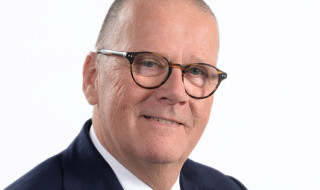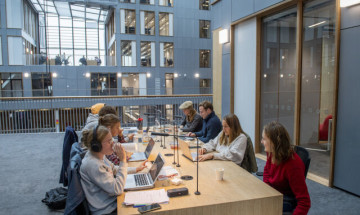Governance on architecture and standards: we do it together!
Working under architecture is the approach for digital transformation in context. It does mean making and keeping agreements. This requires governance. We talked to three experts about this topic. "Not everything is clear yet, but the conversations are taking place."
Marcel Nollen, Board member at Vrije Universiteit and Studielink, Hans Louwhoff, COO at SURF and Oege de Jong, Board member at mboRijnland, give insights into governance on architecture and standards. All are members of the Education Information Room.
The Education Information Room aims to promote public intersectoral cooperation in education in the field of digitalisation and information issues.
In February 2023, this board published the paper 'Governance on architecture and standards, a spade deeper', which once again emphasised the importance of cross-sectoral agreements in relation to the education growth fund programmes.
Staying connected in a complex structure with many layers
How do you agree on architecture and standards? And how do you monitor them? How do you encourage their use? Is it necessary to use enforcement? Governance is a science in itself and it's extra challenging within education and research.

Hans Louwhoff, COO SURF
"It is complex," says Hans. "For instance, there is horizontal and vertical governance. There are layers to it. You can't sit down and talk with a hundred institution directors at once, which is why this is organised stepwise through delegates from the sectors. Conversations take place horizontally across institutions, even across sectors. At that point, you need each other as stakeholders. Subsequently, all layers within institutions need to talk to each other: the architects, CIOs, IT directors. That's vertical governance."
"So there is horizontal and vertical governance. There is stratification in it"
Alignment on architecture and standards therefore happens at many different levels and along various lines, covering this horizontal and vertical axis. It is important to keep connection between all these bodies in the governance structure (see box below).
Various bodies within the governance structure
Information Room - Administrative body that discusses digitalisation and computerisation in the education domain at a strategic level across sectors.
Edustandaard - Network organisation that facilitates collaboration between public and private parties on architecture and standards from an education perspective.
Sectoral architecture steering body - Ownership of sectoral architectures is arranged at the discretion of each sector. Sectoral architecture governing bodies are linked to national decision-making around ROSA and Edustandaard.
Sectoral architecture communities - Sector-organised communities with architects from institutions where coordination with the field can take place.
Architecture boards of programmes - The Architecture boards of the individual growth fund programmes provide first-line quality control within the programme and integral assessment of concrete architectures and designs prepared by the programme.
Enterprise Architecture Teams Sector Partners - Provide further development of sector and reference architectures. They also provide a reference that ensures coherence within the sector and establish targeted sector architectures for the sector.
Getting to know each other well and fine-tuning 'are we talking about the same thing'
"Board members, and I am one of them," Hans continues, "naturally have relatively little knowledge of architecture. That knowledge comes from the architects, specialists and from the people who build the systems. They join our meetings to explain. Recently we said to each other: 'Architecture is a subject for the highest organisational level'. Board members need to be involved in these kinds of digitalisation issues. You can't just leave it to the IT department anymore. You have to think about it thoroughly and define a strategy."
But how does that work? What do you agree on? Who needs to sit at the decision table? On which points do you need commitment?

Oege de Jong, Board member mboRijnland
"It starts with getting to know each other well. Creating trust. Agreeing whether we are really talking about the same thing," says Oege.
He is an ambassador of architecture and standards from the very beginning. "mboRijnland is a merger organisation. When I came to work here, there were all kinds of applications tied together whose origins nobody knew very well anymore, nor which threads you could and could not pull. We called that the 'spaghetti'."
"From the beginning, I said: 'We are now going to put money and time into it, to get it right once and for all'. With an architect, we designed a data layer on which we could then plug in the applications. That gave a lot of structure and was absolutely necessary. A solution like that is suggested by an architect. After that, you have to explain it to your colleagues and bring them along with it."
"From the beginning, I said: 'We are now going to put money and time into it, to get it right once and for all'. With an architect, we designed a data layer"
Oege experienced how costly it can be when institutions do not make sufficient agreements among each other on architectural principles and standards. "There were four universities and a university of applied sciences. Each institution in this project wanted a customised implementation of a student information system, and they got it. The project went belly up financially. Tens of millions went into it. That's a bizarre amount of money for a student information system (SIS)".
Finding each other after a slight power struggle
"It is important to always check with each other whether all interests have been properly addressed," says Hans. "Was everything carefully weighed, was the process followed in the right way and did we not forget anything without getting too deep into the details?"

Marcel Nollen, board member VU (of SURF)
"Finally, you have to come to agreements. This often starts with some minor power struggles, and at some point, through talking, you start to find each other," says Marcel. "You start making agreements together. From there, a mutual demarcation and division of tasks arises that you have to organise well."
Architecture and standards are used to realise joint ambitions such as flexibilisation and lifelong development. "These innovations are too important to tackle individually," Marcel continues. "I dare say that we are on the right track within this topic."
"Within the education domain, hard work is being done on innovation. To this end, strategic agendas have been drawn up for, for example, Lifelong Development, Flexibilisation and the Continuous Learning Line. This requires cooperation in many areas, which also places demands on the provision of information. Agreements on architecture and standards are essential to realise these goals. In recent years, bodies have been set up to make governance agreements and cooperate on architecture and standards."
From the paper Governance on architecture and standards, a spade deeper (February 2023).
Agreements at the front end
Architecture helps to make agreements at the front end, avoiding repair work at the back end. After all, that is much more expensive. It is smarter to invest before the problem arises. Giving direction at the front results in a completely different conversation than saying afterwards 'it didn't go well, how come?'
"You talk to each other from a completely different perspective," Hans explains. "Not everything is clear yet, but you are talking to each other."
He sees a special role for SURF as an IT organisation. "We issue warnings, for example. On one hand, we see that big tech provide good stuff, which is pleasant to use, but on the other hand we ask ourselves: what if the footprint of mostly big American companies in education gets bigger and bigger? Starting with an operating system, then an office suite and then various education, security and AI solutions. It means you become very dependent on a particular vendor. We have to think about that together."
Dialogue on trade-offs
Once standards are agreed upon, they are recorded in Edustandaard. Edustandaard publishes the cross-sector frameworks, infrastructure building blocks, standards and concepts. Edustandaard also monitors the development of new infrastructure building blocks and standards. Finally, it monitors that no duplication takes place.
Subsequently, however, the institutions themselves have to implement those standards.
"The way we make decisions together and organise ourselves is really different in a university than in a company"
"Our sector is a very autonomous one," says Hans. "That is a strength on the one hand, but on the other hand it also makes it difficult at times. You have to focus on persuasion, not on coercion. Coercion doesn't work."
"The way we make decisions together and organise ourselves is really different in a university than in a company," says Marcel. "You have to do a lot more with persuasion and seduction."
After that, it comes down to managerial commitment. That plays a big role. From that commitment, the knowledge that the standards are there and that it is important to comply with them can spread like an oil spill within the institutions' own organisation and IT departments,
This is where different dynamics come into play. Marcel: "An IT department with its own views; a central student and education affairs department; the faculties themselves, where one is engaged in capital-intensive education and research and the other has little or none; and finally in the medical department, which is also very different. Each sector and faculty more or less lives in its own bubble, where they do see themselves as part of the bigger picture, yet from a sense of being unique they ask for customisation."With the risk of creating spaghetti."
"In the end it's important to explain your considerations. You have to have good dialogues about that."
And that's when we need each other: to start those dialogues.
Text: Maureen van Althuis
'Governance on architecture and standards: we do it together!' is an article from SURF Magazine.
Questions following this article? Mail to magazine@surf.nl
